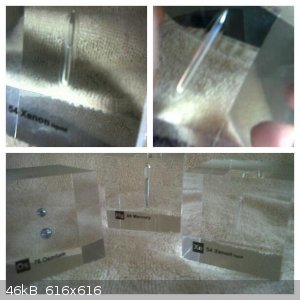
nhindori - 25-11-2014 at 16:15
Here is a great picture capturing xenon as a liquid, gas, supercritival fluid producing a flash of blue light .The pressure inside is over 940 psi !!
Th pictures dont capture the mystery of this element.
I know the density of xenon liquid is over 3 g/cm3 and as a gas about 5 g / l so 0.005 g/ cm3 i believe but theoretically if i had 1 ml of xenon
liquid at 940 psi how much gas would that be equivalent to at atmospheric pressure?
Gas can usually be ionized but would a pressurized gas ionize near high voltage fields?

Bezaleel - 26-11-2014 at 08:56
Yes, a pressurised gas also ionises. You can ionise water (or any other liquid or solid), if you supply sufficient current (and voltage), yielding an
under water arc. I don't know about the density inside the arc, though. This does develop a considerable amount of heat, as you probably will have
guessed.
neptunium - 5-12-2014 at 15:47
i vaguely remember that mono atomic gases are good approximations for the equation of state.
1 mol (at room preassure and temp.) occupy 22.4 l.
so if you have 1 ml or 1 cm3. or about 3g thats 3/131= 0.0229mol.
0.0229X22.4= 0.51 l or about 510 ml.
or
PV=NRT hence V=(NRT)/P
P=1atm N=0,0229mol R=0,08206 T=273K V= liters
note that this is a useful aproximation at constant temperature and the pressure or change of state doesnt change a thing when you know exactly how
much matter is involve .
the change of state reflect the density reaching the gas or liquid phase when preassure is raised or dropped.
[Edited on 6-12-2014 by neptunium]
